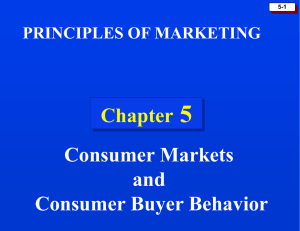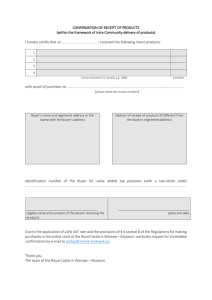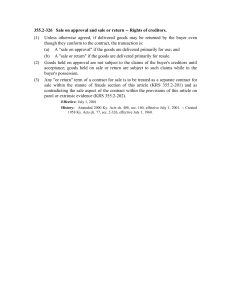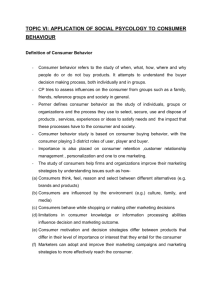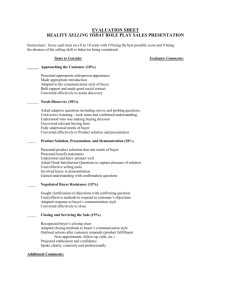Consumer Markets and Consumer Buyer Behavior
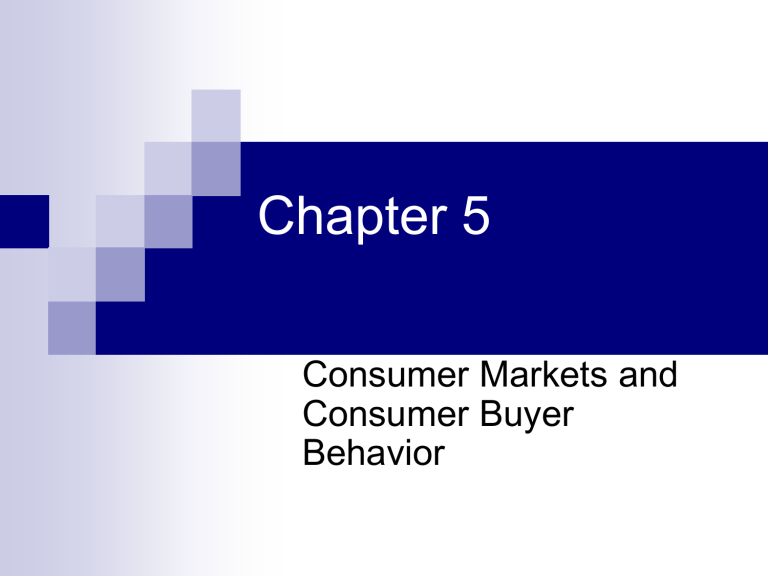
Chapter 5
Consumer Markets and
Consumer Buyer
Behavior
Schedule – Before Midterm
4 Oct.8/9 Consumer Markets and
Consumer Buyer Behavior
Ch.5
Case 3
5 Oct.15/16 Business Markets and Business
Buyer Behavior
Ch.6
Case 4
6 Oct.22/23 Marketing Information System Ch.4
Case 5
2
Learning Goals
1.
2.
3.
4.
Define the consumer market and construct a model of consumer buyer behavior
Name the four factors that influence buyer behavior
List and understand the types of buying decision behavior and stages in the process
Describe the adoption and diffusion process for new products
3
Case Study
Harley Davidson
Building Success
Understanding the customers’ emotions and motivation
Determining the factors of loyalty
Translating this information to effective advertising
Measuring Success
Currently 22% of all U.S. bike sales
Demand above supply
Sales doubled in the past
5 years with earnings tripled
5 - 4
Learning Goals
1.
2.
3.
4.
Define the consumer market and construct a model of consumer buyer behavior
Name the four factors that influence buyer behavior
List and understand the types of buying decision behavior and stages in the process
Describe the adoption and diffusion process for new products
5
Definitions
Consumer buyer behavior refers to the buying behavior of final consumers – individuals and households who buy goods and services for personal consumption
All of these final consumers combine to make up the consumer market
6
7
Learning Goals
1.
2.
3.
4.
Define the consumer market and construct a model of consumer buyer behavior
Name the four factors that influence buyer behavior
List and understand the types of buying decision behavior and stages in the process
Describe the adoption and diffusion process for new products
8
Model of Buyer Behavior
Characteristics Affecting
Consumer Behavior
Key Factors
Cultural
Social
Personal
Psychological
Culture
Forms a person’s wants and behavior
Subculture
Groups with shared value systems
Social Class
Society’s divisions who share values, interests and behaviors
10
Characteristics Affecting
Consumer Behavior
Key Factors
Cultural
Social
Personal
Psychological
Groups
Membership
Reference
Aspirational
Opinion leaders
Buzz marketing
Family
Many influencers
Roles and status
11
This advertiser knows teens are strongly influenced by groups when purchasing fashion items
Characteristics Affecting
Consumer Behavior
Key Factors
Cultural
Social
Personal
Psychological
Age and life cycle
Occupation
Economic situation
Lifestyle
Activities, interests and opinions
Lifestyle segmentation
Personality and self-concept
13
Personal Factors
Family Life Cycle stages throughout which families pass as they mature over time
Stages in family life cycle:
1.bachelor stage
2.newly married couples, no children
3.full nest 1; youngest child under 6
4.full nest 2; youngest child 6 or over
5. full nest 3; older married couples with dependent children
6.empty nest 1; older married couples no children with them
7. empty nest 1; older married couples no children at home;retired
8.solitary survivor, working
9.solitary survivor, retired
14
Personal Factors
Personality a person’s unique characteristics that lead to relatively consistent and lasting responses to his environment
Self-concept the self image or general picture that people have of themselves
15
Personal Factors
Lifestyle a person’s pattern of living as expressed in his activities, interests and opinions
Psychographics technique of measuring lifestyles and developing lifestyle classifications
Major dimensions measured are:
Activities (work, hobbies, social events, entertainment, shopping, sports,vacation)
Interests (family, home, job, recreation, fashion, food, media, achievements)
Opinions (themselves, social issues, politics, business, economics, products, future)
16
Values and Lifestyles (VALS)
High Innovation
High Resources
Actualizers
Fulfilleds
Believers
Achievers
Strivers
Strugglers
Experiencers
Makers
Low Resources Low Innovation
17
Brand Personality Dimensions
Sincerity
Ruggedness
Excitement
Competence
Sophistication
18
Characteristics Affecting Consumer
Behavior
Key Factors
Cultural
Social
Personal
Psychological
Motivation
Perception
Learning
Beliefs and attitudes
19
Psychological Factors
Motivation
A motive is a need that is sufficiently pressing to direct the person to seek satisfaction
Motivation research is based on Freud.
Looks for hidden and subconscious motivation
Maslow ordered needs based on how pressing they are to the consumer
20
Maslow’s Hierarchy of Needs
This ad demonstrates a product meeting physiological and social needs
Discussion
What consumer products might fulfill multiple levels of the
Hierarchy of Needs?
Psychological Factors
Perception
Perception is the process by which people select, organize, and interpret information.
Perception Includes:
Selective attention
Consumers screen out information
Selective distortion
People interpret to support beliefs
Selective retention
People retain points to support attitudes
24
Discussion Question
Perception
1.
2.
How many ads were you exposed to today?
Which ones do you remember? Why?
Psychological Factors
Learning
Learning describes changes in an individual’s behavior arising from experience
Learning occurs through
Drives
Internal stimulus that calls for action
Stimuli
Objects that move drive to motive
Cues
Minor stimuli that affect response
Reinforcement
Feedback on action
26
Psychological Factors Beliefs and Attitudes
Belief
a descriptive thought about a brand or service
may be based on real knowledge, opinion, or faith
Attitude
describes a person’s evaluations, feelings and tendencies toward an object or idea
They are difficult to change
27
Learning Goals
1.
2.
3.
4.
Define the consumer market and construct a model of consumer buyer behavior
Name the four factors that influence buyer behavior
List and understand the types of buying decision behavior and stages in the process
Describe the adoption and diffusion process for new products
28
29
Types of Buying
Decision Behavior
The Buying Roles
5 roles people might play in a buying decision
Initiator who first gives the idea of buying the product or service
Influencer decision
Decider decision
Buyer
User
31
The Buyer Decision Process
The Buyer Decision
Process
Process Stages
Need recognition
Information search
Evaluation of alternatives
Purchase decision
Postpurchase behavior
Needs can be triggered by:
Internal stimuli
Normal needs become strong enough to drive behavior
External stimuli
Advertisements
Friends of friends
33
The Buyer Decision
Process
Process Stages
Need recognition
Information search
Evaluation of alternatives
Purchase decision
Postpurchase behavior
Consumers exhibit heightened attention or actively search for information
Sources of information:
Personal
Commercial
Public
Experiential
Word-of-mouth
34
Information Search
Personal Sources
Commercial Sources
Public Sources
Experiential Sources
•Family, friends, neighbors
•Most effective source of information
•Advertising, salespeople
•Receives most information from these sources
•Mass Media
•Consumer-rating groups
•Handling the product
•Examining the product
•Using the product
35
The Buyer Decision
Process
Process Stages
Need recognition
Information search
Evaluation of alternatives
Purchase decision
Postpurchase behavior
Evaluation procedure depends on the consumer and the buying situation.
Most buyers evaluate multiple attributes, each of which is weighted differently.
At the end of the evaluation stage, purchase intentions are formed.
36
Evaluation of Alternatives
Consumer May Use Careful
Calculations & Logical Thinking
Consumers May Buy on Impulse and
Rely on Intuition
Consumers May Make Buying Decisions on Their Own.
Consumers May Make Buying Decisions
Only After Consulting Others .
Marketers Must Study Buyers to Find Out
How They Evaluate Brand Alternatives
37
Decision Making Sets
Total
Set
Awareness
Set
Consideration
Set
Choice
Set Decision
38
The Buyer Decision
Process
Process Stages
Need recognition
Information search
Evaluation of alternatives
Purchase decision
Postpurchase behavior
Two factors intercede between purchase intentions and the actual decision:
Attitudes of others
Unexpected situational factors
39
Buyer Decision Process for
New Products
New Products
Good, service or idea that is perceived by customers as new.
Stages in the Adoption Process
Marketers should help consumers move through these stages.
40
Stages in the Adoption Process
Awareness : Consumer is aware of product, but lacks information.
Interest : Consumer seeks
Information about new product.
Evaluation : Consumer considers trying new product.
Trial : Consumer tries new product on a small scale.
Adoption : Consumer decides to make regular use of product.
41
Buyer Decision Process for
New Products
Individual Differences in Innovativeness:
Consumers can be classified into five adopter categories , each of which behaves differently toward new products
42
Adopter Categories
Early Majority
2.5%
Early
Early
Adopters
13.5%
34%
Late Majority
34%
Time of Adoption
Laggards
16%
Late
43
Buyer Decision Process for
New Products
Product Characteristics influencing the adoption rate:
Relative Advantage Is the innovation superior to existing products?
Compatibility Does the innovation fit the values and experience of the target market?
Complexity Is the innovation difficult to understand or use?
Divisibility Can the innovation be used on a trial basis?
Communicability Can results be easily observed or described to others?
44
Buyer Decision Process for
New Products
International Consumer Behavior
Values, attitudes and behaviors differ greatly in other countries.
Physical differences exist which require changes in the marketing mix.
Customs vary from country to country.
Marketers must decide the degree to which they will adapt their marketing efforts.
45
Discussion Question
How is a site like
Consumer
Reports used in the decisionmaking process?
Discussion Question
Why might the adoption process be slow for a home robot?
Source: Business Week
Source: Business Week
The Buyer Decision
Process
Process Stages
Satisfaction is important:
Delighted consumers engage in positive wordof-mouth.
Unhappy customers tell on average 11 other people.
Cognitive dissonance is common
Need recognition
Information search
Evaluation of alternatives
Purchase decision
Postpurchase behavior
48
Learning Goals
1.
2.
3.
4.
Define the consumer market and construct a model of consumer buyer behavior
Name the four factors that influence buyer behavior
List and understand the types of buying decision behavior and stages in the process
Describe the adoption and diffusion process for new products
49
50
Ramazan Bayraminiz Kutlu & Mutlu olsun!!!
For Next Week
Read Chapter 6
Be prepared for case 4 – Kodak discussion
51


